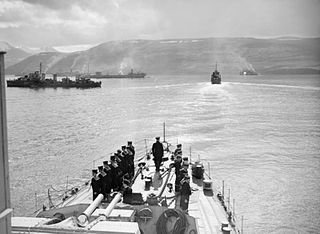
Convoy PQ 17 was an Allied Arctic convoy during the Second World War. On 27 June 1942, the ships sailed from Hvalfjörður, Iceland, for the port of Arkhangelsk in the Soviet Union. The convoy was located by German forces on 1 July, shadowed and attacked.

USS Fairfax (DD-93) was a Wickes-class destroyer in the United States Navy during World War I, later transferred for World War II service first to the Royal Navy as HMS Richmond (G88), a Town-class destroyer, and then to the Soviet Navy as Zhivuchy.

The Arctic convoys of World War II were oceangoing convoys which sailed from the United Kingdom, Iceland, and North America to northern ports in the Soviet Union – primarily Arkhangelsk (Archangel) and Murmansk in Russia. There were 78 convoys between August 1941 and May 1945, sailing via several seas of the Atlantic and Arctic oceans, with periods with no sailings during several months in 1942, and in the summers of 1943 and 1944.
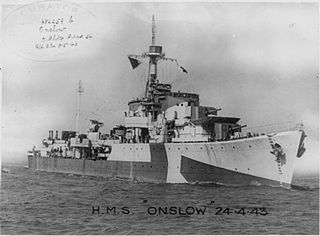
HMS Onslow was an O-class destroyer of the Royal Navy. The O-class were intermediate destroyers, designed before the outbreak of the Second World War to meet likely demands for large number of destroyers. They had a main gun armament of four 4.7 in guns, and had a design speed of 36 kn. Onslow was ordered on 2 October 1939 and was built by John Brown & Company at their Clydebank, Glasgow shipyard, launching on 31 March 1941 and completing on 8 October 1941.

Convoy PQ 18 was an Arctic convoy of forty Allied freighters from Scotland and Iceland to Arkhangelsk in the Soviet Union during the Second World War. The convoy departed Loch Ewe, Scotland on 2 September 1942, rendezvoused with more ships and escorts at Iceland and arrived at Arkhangelsk on 21 September. An exceptionally large number of escorts were provided by the Royal Navy in Operation EV, including the first escort carrier to accompany an Arctic convoy. Detailed information on German intentions was provided by the code breakers at Bletchley Park and elsewhere, through Ultra signals decrypts and eavesdropping on Luftwaffe wireless communications.
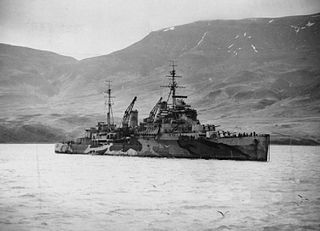
PQ 13 was a British Arctic convoy that delivered war supplies from the Western Allies to the USSR during World War II. The convoy was subject to attack by German air, U-boat and surface forces and suffered the loss of five ships, plus one escort vessel. Fifteen ships arrived safely.

HMS Fury was an F-class destroyer built for the Royal Navy in the 1930s. Although assigned to the Home Fleet upon completion, the ship was attached to the Mediterranean Fleet in 1935–36 during the Abyssinia Crisis. During the Spanish Civil War of 1936–1939, she spent time in Spanish waters, enforcing the arms blockade imposed by Britain and France on both sides of the conflict. The ship escorted the larger ships of the fleet during the early stages of World War II and played a minor role in the Norwegian Campaign of 1940. Fury was sent to Gibraltar in mid-1940 and formed part of Force H where she participated in the attack on Mers-el-Kébir and the Battle of Dakar. The ship escorted numerous convoys to Malta in 1940–41 and Arctic convoys during 1942.

Unternehmen Rösselsprung was a plan by the German Navy to intercept an Arctic convoy in mid-1942. It was the largest operation of its type mounted by the Kriegsmarine and resulted in the near-destruction of Convoy PQ 17. The success of the operation was indirect in that none of the ships engaged the convoy, its losses being inflicted by U-boat and aircraft attacks. Despite not making contact with the convoy a number of the ships of Unternehmen Rösselsprung were damaged and the heavy cruiser Lützow, ran aground in thick fog, needing three months of repairs.
HMS Marigold was a Flower-class corvette of the Royal Navy. She was launched on 4 September 1940 and was sunk by an Italian air-dropped torpedo on 9 December 1942.
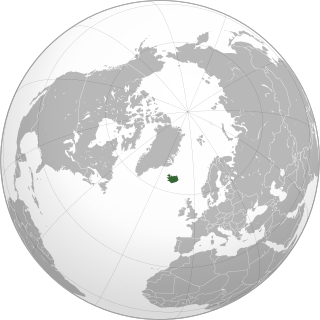
Operation FB took place as part of the Arctic Convoys of the Second World War. The operation consisted of independent sailings by unescorted merchant ships between Iceland and Murmansk. In late 1942, the Allies had taken the offensive against Germany but the dispatch of supplies to the USSR by convoy via the Arctic route was suspended, due to the demands of the Mediterranean campaign. Convoy PQ 19 was cancelled because the Home Fleet diverted ships to the Mediterranean for Operation Torch which would have had to be postponed for three weeks had ships been provided for Convoy PQ 19.

Convoy PQ 15 was an Arctic convoy sent from Iceland by the Western Allies to aid the Soviet Union during the Second World War. The convoy sailed in late April 1942, reaching the Soviet northern ports after air attacks that sank three ships out of twenty-five.
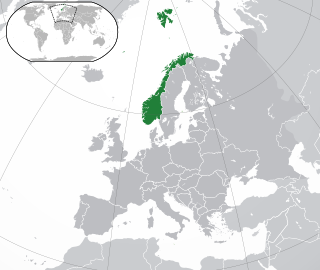
Convoy PQ 14 was an Arctic convoy sent from Britain by the Western Allies to aid the Soviet Union during the Second World War. Convoys from Britain had been despatched since August 1941 and advantage had been taken of the perpetual darkness of the Arctic winter. German operations against the convoys had been muted due to the need to support Operation Barbarossa, confidence in imminent victory and the small size of the convoys. In late 1941 and early 1942 the Luftwaffe and Kriegsmarine had reinforced Norway with aircraft and ships.

Convoy PQ 12 was an Arctic convoy sent from Reykjavík in Iceland by the Western Allies to aid the Soviet Union during the Second World War. It sailed 1 March 1942, reaching Murmansk on 12 March 1942 for no losse despite a sortie against it by the Tirpitz.

Convoy PQ 8 was an Arctic convoy of the Western Allies to aid the Soviet Union during the Second World War. The convoy left Iceland on 8 January 1942. On 12 January the convoy had to turn south to avoid ice; the weather was calm, visibility was exceptional, with a short period of twilight around noon. and arrived in Murmansk nine days later.

Convoy QP 11 was an Arctic Convoy of World War II, made up of merchant ships returning from the Soviet Union to Britain after delivering their cargo to the Soviet Union. The convoy consisted of 13 merchant ships, escorted by 18 warships. The convoy was attacked by German destroyers and submarines, suffering the loss of one merchant ship as well as the light cruiser HMS Edinburgh. The Germans lost the destroyer Z7 Hermann Schoemann.
Convoy QP 10 was an Arctic convoy of World War II, consisting of empty merchant ships returning from the Soviet Union after delivering their cargo there. The convoy consisted of 16 merchant ships and an escort of nine warships. The convoy departed Murmansk on 10 April 1942 and arrived in Reykjavik on 21 April. The convoy was attacked by German U-boats and aircraft, resulting in the loss of four merchant ships. Another ship, Stone Street, was damaged by air attack and forced to turn back to the Kola Inlet. The convoy's escorts shot down six German planes and damaged another during the course of the voyage. Later, six merchant ships from Convoy PQ 14 joined QP 10.

HMS Zephyr was a Z-class destroyer. She was launched on 13 July 1942 at Vickers-Armstrongs' High Walker shipyard and commissioned on 6 September 1944. She was 'adopted' by the civil community of Doncaster, replacing the destroyer HMS Lightning, which had originally been adopted during Warship Week in 1942.

Gremyashchy was one of 29 Gnevny-class destroyers built for the Soviet Navy during the late 1930s. Completed in 1939, she was assigned to the Baltic Fleet and was later transferred to the Northern Fleet in 1941.

Convoy QP 1 was the first Arctic Convoy of the Second World War by which the Allies brought back the ships of Operation Dervish that had carried supplies to the Soviet Union after Operation Barbarossa, the German invasion of 22 June 1941. The convoy sailed from Murmansk on 28 September 1941 and arrived safely at Scapa Flow in Orkney on 19 October.




























